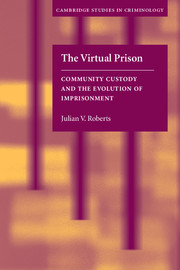Book contents
- Frontmatter
- Contents
- List of figures and tables
- Foreword by Andrew Ashworth
- Preface
- 1 Introduction to the concept of community custody
- 2 The way we punish now
- 3 Conceptualizing community custody
- 4 Representative models of community custody
- 5 Coming home to prison: offender perceptions and experiences
- 6 The effect of community custody on prison admissions
- 7 Public attitudes to community custody
- 8 Making community custody sentences work
- Notes
- References
- Index
7 - Public attitudes to community custody
Published online by Cambridge University Press: 07 December 2009
- Frontmatter
- Contents
- List of figures and tables
- Foreword by Andrew Ashworth
- Preface
- 1 Introduction to the concept of community custody
- 2 The way we punish now
- 3 Conceptualizing community custody
- 4 Representative models of community custody
- 5 Coming home to prison: offender perceptions and experiences
- 6 The effect of community custody on prison admissions
- 7 Public attitudes to community custody
- 8 Making community custody sentences work
- Notes
- References
- Index
Summary
Although there is now an extensive literature on public attitudes towards sentencing, and alternatives to traditional imprisonment, most of this research focuses on alternative sanctions other than community custody: far less is known about public reaction to terms of imprisonment served at home. One reason for this is the relative novelty of this sanction in many jurisdictions. Researchers have explored public reaction to some elements of community custody, such as home detention, electronic monitoring, and curfews; this work sheds light on public opinion regarding community custody, and will be examined here. As well, researchers in Canada have surveyed the public with respect to the community custody sentence, with interesting results.
After discussing public reaction to alternative sanctions in general terms, this chapter explores the extent of public knowledge, and nature of public opinion regarding community custody. The research findings suggest that if community custody is properly conceived, and fully explained to the community, it is seen as a satisfactory substitute for institutional imprisonment for a wide range of offences. Public support for community custody seems to increase as the conditions imposed on the offender become more restrictive. However, for the present at least, the public appear to draw the line at using this sanction for the most serious personal injury offences. For these crimes, the public continue to regard penal sequestration as the only appropriate criminal justice response.
- Type
- Chapter
- Information
- The Virtual PrisonCommunity Custody and the Evolution of Imprisonment, pp. 131 - 153Publisher: Cambridge University PressPrint publication year: 2004



